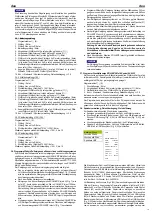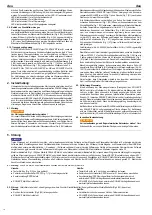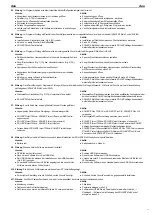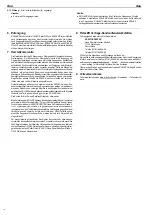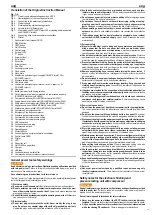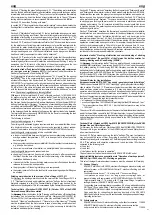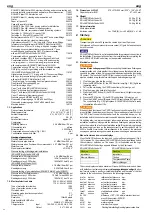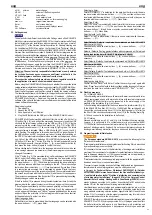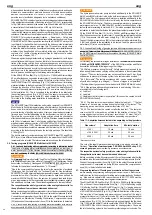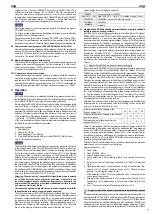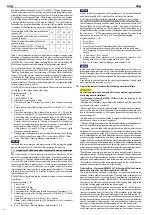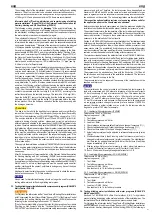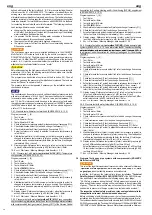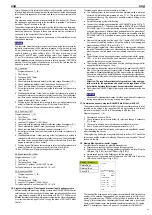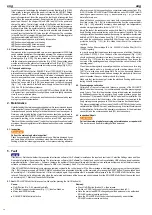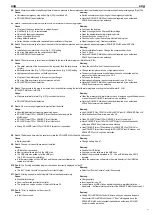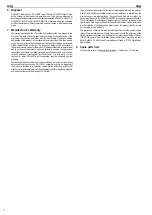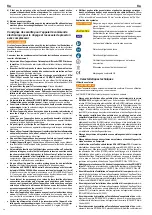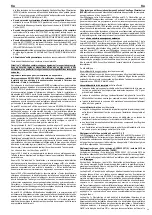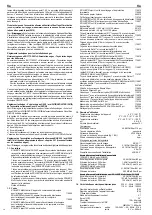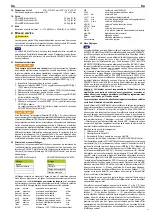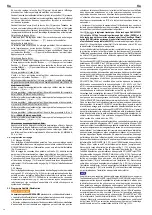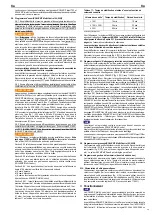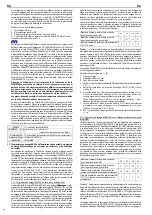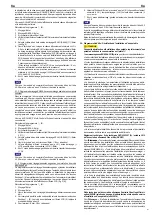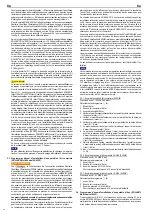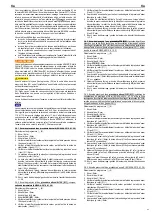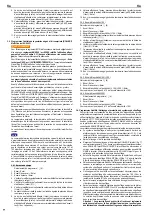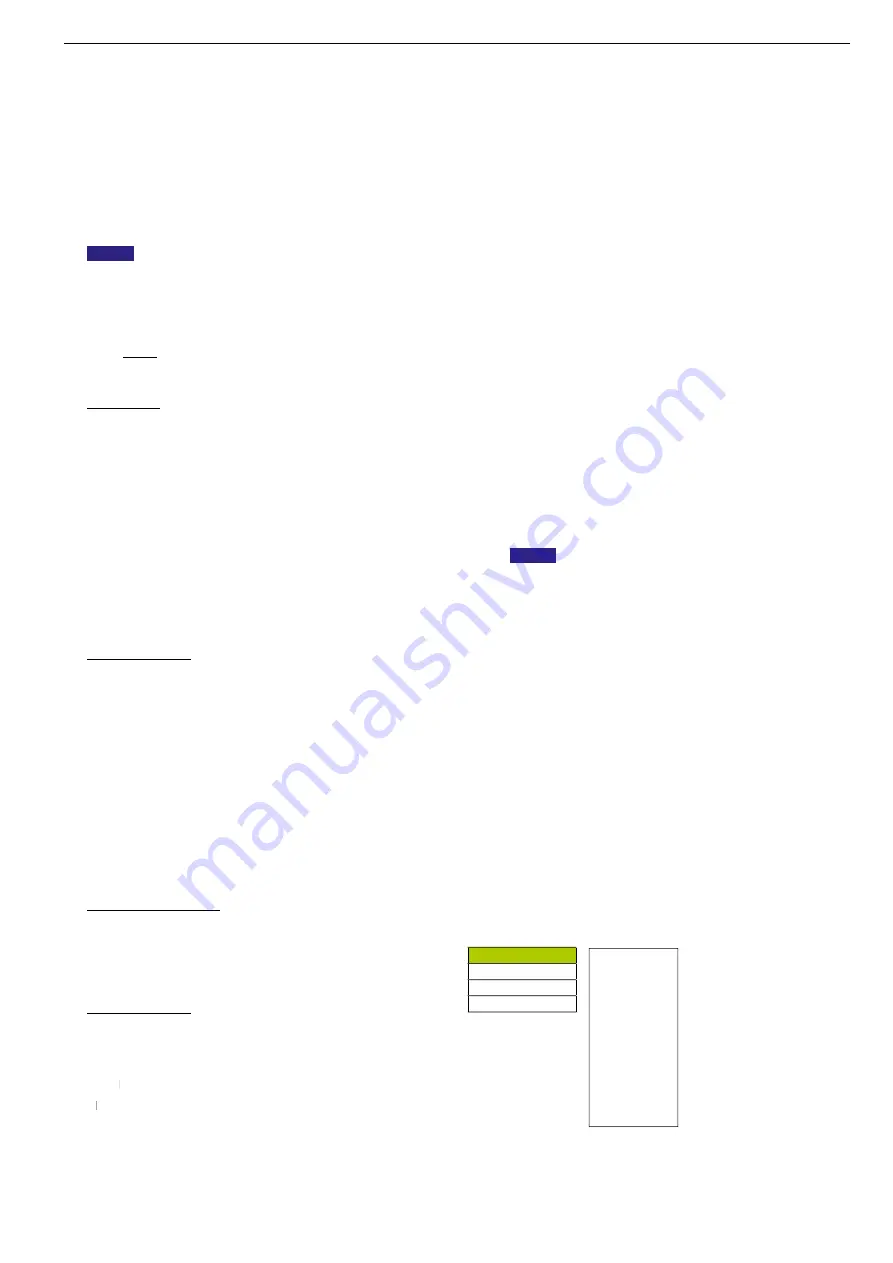
eng eng
Future changes to this information leafl et or the respective valid provisions,
rules and regulations for the application site must be considered and changed
test criteria (test sequences, pressures and times) must be corrected in the
defaults.
The programs can be aborted at any time with the Esc button (10). Then all
the valves open and the pressure in the installation is released. The tests are
saved but "Cancel" is shown in the fi le.
The ambient temperature, the temperature of the test medium and the atmos-
pheric air pressure can infl uence the result of the test because they affect the
measured pressures. Changes in these parameters must be considered, if
necessary, in the evaluation of the test results.
The pressure test must be repeated if necessary or the installation must be
checked and improved.
NOTICE
NOTICE
The controller ends the control process to set the selected test pressure for
tests with compressed air ≤ 200 mbar at a tolerance of ±3 mbar and for tests
≤ 3 bar (if necessary ≤ 4 bar) at a tolerance of ±0.1 bar. This means that the
control is ended, e.g. when setting p refer = 150 mbar at a value p actual
between 147 and 153 mbar or when setting p refer = 3 bar between 2.9 and
3.1 bar. This tolerance is safe because, in the pressure test with compressed
air, the relative pressure change of pressure p refer is decisive. If ENTER is
pressed, the value p actual is taken over as p refer. So the test can also be
begun at a p refer of 153 mbar for example.
3.5.1. Load test
Program sequence ↑ ↓ (8):
1. Test \ Enter
2. Test gas with air \ Enter
3. Load test \ Enter
4. Check reference test pressure default (p refer) and change if necessary (11) \ ↓
5. Check stabilisation default (t stabi) and change if necessary (11) \ ↓
6. Check test time default (t test) and change if necessary (11) \ ↓
7. Actual test pressure (p actual) is adjusted to reference test pressure (p
refer) \ Enter
8. Stabilisation/wait time (t stabi) running, actual test pressure (p actual) is
changed to reference test pressure (p refer) on expiring. The stabilisation/
wait time can be ended prematurely with Enter, the test time (t test) then
begins immediately (\ Esc = cancel).
9. Display screen: Reference test pressure (p refer), actual test pressure (p
actual), differential test pressure (p diff), test time (t test) \ Enter
10. Esc >> Start menu \ Memory Manager, data transfer >> 3.8
3.5.2. Leak test <100 l
Program sequence ↑ ↓ (8):
1. Test \ Enter
2. Test gas with air \ Enter
3. Leak test ("Tightness") <100 l \ Enter
4. Check reference test pressure default (p refer) and change if necessary (11) \ ↓
5. Check stabilisation default (t stabi) and change if necessary (11) \ ↓
6. Check test time default (t test) and change if necessary (11) \ ↓
7. Actual test pressure (p actual) is adjusted to reference test pressure (p
refer) \ Enter
8. Stabilisation/wait time (t stabi) running, actual test pressure (p actual) is
changed to reference test pressure (p refer) on expiring. The stabilisation/
wait time can be ended prematurely with Enter, the test time (t test) then
begins immediately (\ Esc = cancel).
9. Display screen: Reference test pressure (p refer), actual test pressure (p
actual), differential test pressure (p diff), test time (t test) \ Enter
10. Esc >> Start menu \ Memory Manager, data transfer >> 3.8
3.5.3.Leak test ≥100 l <200 l
Program sequence ↑ ↓ (8):
1. Test \ Enter
2. Test gas with air \ Enter
3. Leak test ("Tightness") ≥100 l <200 l \ Enter
For further procedure, see leak test <100 l, 4. to 10.
3.5.4. Leak test ≥200 l
Program sequence ↑ ↓ (8):
1. Test \ Enter
2. Test gas with air \ Enter
3. Leak test ("Tightness") ≥200 l \ Enter
For further procedure, see leak test <100 l, 4. to 10.
For fur
For fur
3.6. Programs Ingredients / C
3.6. Pr
3.6. Pr
leaning and preservation of heating systems
Before cleaning and preserving heating systems with ROLLER’S Multi-Control,
safety devices for the prevention of drinking water contamination by fl owback,
e.g. pipe network separator BA in accordance with EN 1717:2000 must be
installed to protect the drinking water against contamination. Never allow cleaner
or corrosion protection agent to fl ow though the pipes of ROLLER’S Multi-
Control.
The cleaning and preservation procedure is as follows:
● The heating system to be cleaned is fl ushed preferably with a water-air
mixture with intermittent compressed air (see 3.1.4.). This reinforces the
subsequent cleaning. Pay attention to possible pressure limiting of the
heating system!
● Empty the heating system after fl ushing.
● Connect the cleaning and preservation unit ROLLER’S Inject H (Fig. 7),
as described under 2.7. The nozzles installed in ROLLER’S Inject TW and
ROLLER’S Inject H for automatic dosing of dosing solution, cleaner and
corrosion protection are different sizes and adapted to the properties of
the ROLLER ingredients to be injected. Therefore, always make sure that
ROLLER’S Inject H is connected for cleaning and preserving the heating
system.
● Remove the locking ring from the cap of the 1 l bottle of ROLLER’S Plus
H-R cleaner for heating systems. Screw the bottle to the cleaning and
preservation unit ROLLER’S Inject H (Fig. 7).
● Select program Ingredients \ Cleaning Heating. A drain must be opened at
the end of the heating system to be cleaned during the fi lling process. This
must stay open until the green coloured cleaning solution fl ows out from
there.
● The bottle may have to be changed to clean heating systems with > approx.
100 l . To do this, close the supply and drain and remove the bottle (21)
slowly so that excess pressure can escape.
● The cleaning solution must be drained from the heating pipes again after
an application time of approx. 1 hour.
● After cleaning, the heating system is refi lled with the addition of ROLLER’S
Plus H-K corrosion protection for preservation of heating systems (program
Ingredients \ Preservation Heating) until the blue coloured corrosion protec-
tion solution emerges The bottle is fi tted and changed as described above.
The corrosion protection solution then remains permanently in the heating
system.
Attention: The respective national safety provisions, rules and regu-
lations valid for the application site as well as the regulations of the
hot water boiler manufacturer must be considered and observed.
● Flush/clean the ROLLER’S Inject H thoroughly with clean water at the end
of work.
NOTICE
NOTICE
Hoses used for cleaning/preservation should no longer be used for pressure
testing with water and for fl ushing drinking water pipes.
3.7. Compressed air pump program ROLLER’S Multi-Control SL/SLW
The pressure is displayed and controlled to the reference test pressure (p refer)
selected on the screen in the range from 200 to 0 descending in hPa (mbar,
psi) and in the range from 0.2 to 8.0 ascending in MPa (bar, psi).
Program sequence ↑ ↓ (8):
1. Compressed air pump \ Enter
2. Check reference test pressure default (p refer) and change if necessary
(11) \ Enter
3. The vessel is pumped up to the reference test pressure (p refer).
4. Esc >> Start menu \ Memory Manager, data transfer >> 3.8
The pressure of a vessel that is already under pressure is specifi ed as p actual
after connecting the vessel.
The program can be aborted at any time with the Esc button (10). Then all the
valves open and the pressure is released. The pump-up is saved but "Cancel"
is shown in the fi le.
3.8. Memory Manager, data transfer, logging
Four functions are provided for memory management:
● Display saved results of the fl ushing and testing programs
● Print saved results of the fl ushing and test programs on a printer. Plug the
USB lead (Fig. 9 (45)) into the USB port (Fig. 2 (33)).
● Delete saved results of the fl ushing and testing programs
● Save results of the fl ushing and test programs on a USB stick. Plug in the
USB stick at the USB port (Fig. 2 (33)).
Display / Pressure
Delete fi le no.
Delete all fi les
Save USB
Customer:
ROLLER’S Multi-Control
Date: 28.05.2016
Hour:
13 :22
File-No. 000051
Test with water A
p prefer bar
11.3
p actual bar
11.3
p diff
bar
0.0
t test
min
002 : 00
Tester:
The results of the fl ushing
The results
The results
and test programs are saved with date, time and log
number in the selected language and can be transferred to a USB stick or
printer (accessory part no. 115604) (neither of which is included in the scope
of supply) for documentation. Necessary additions to saved data, e.g. customer
name, project number, tester, are possible on external devices (e.g. PC, laptop,
tablet PC, smartphone). Paper roll, pack of 5, for printer (Art. No. 090015).
29

